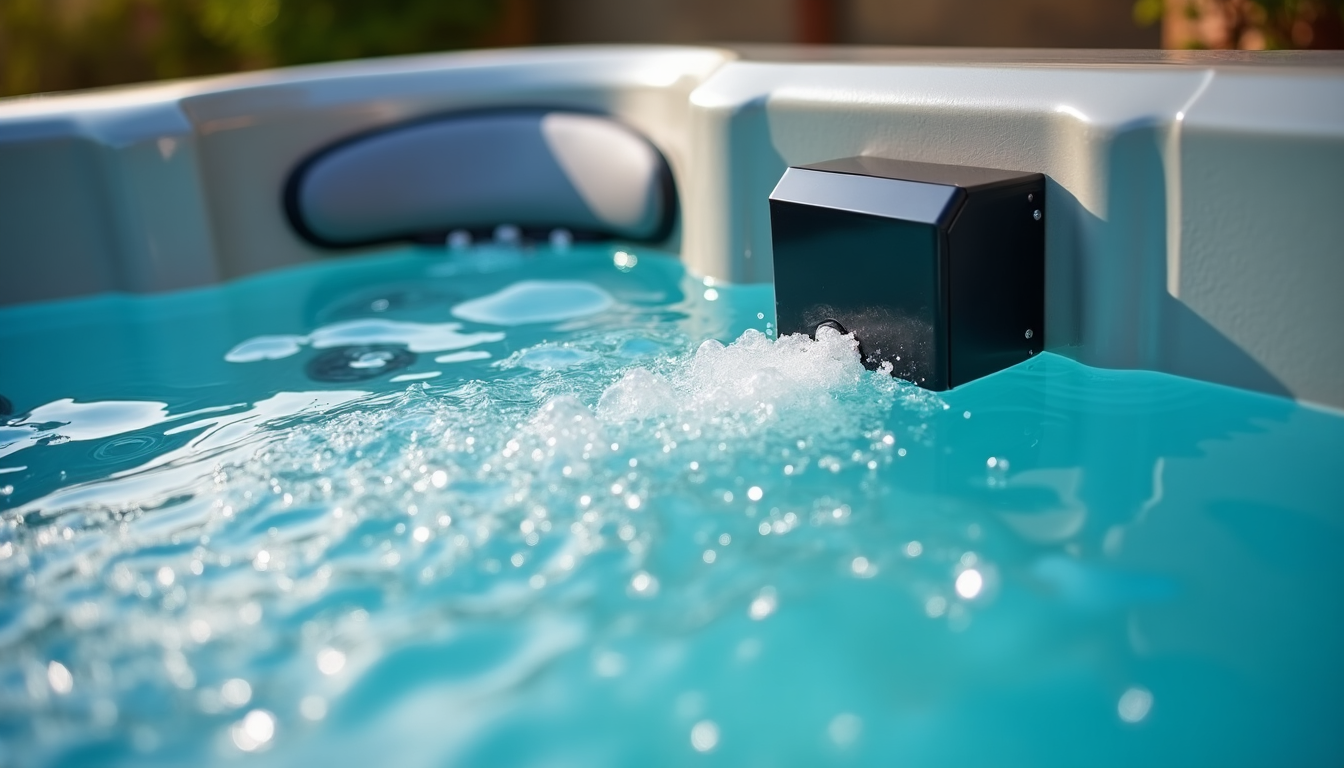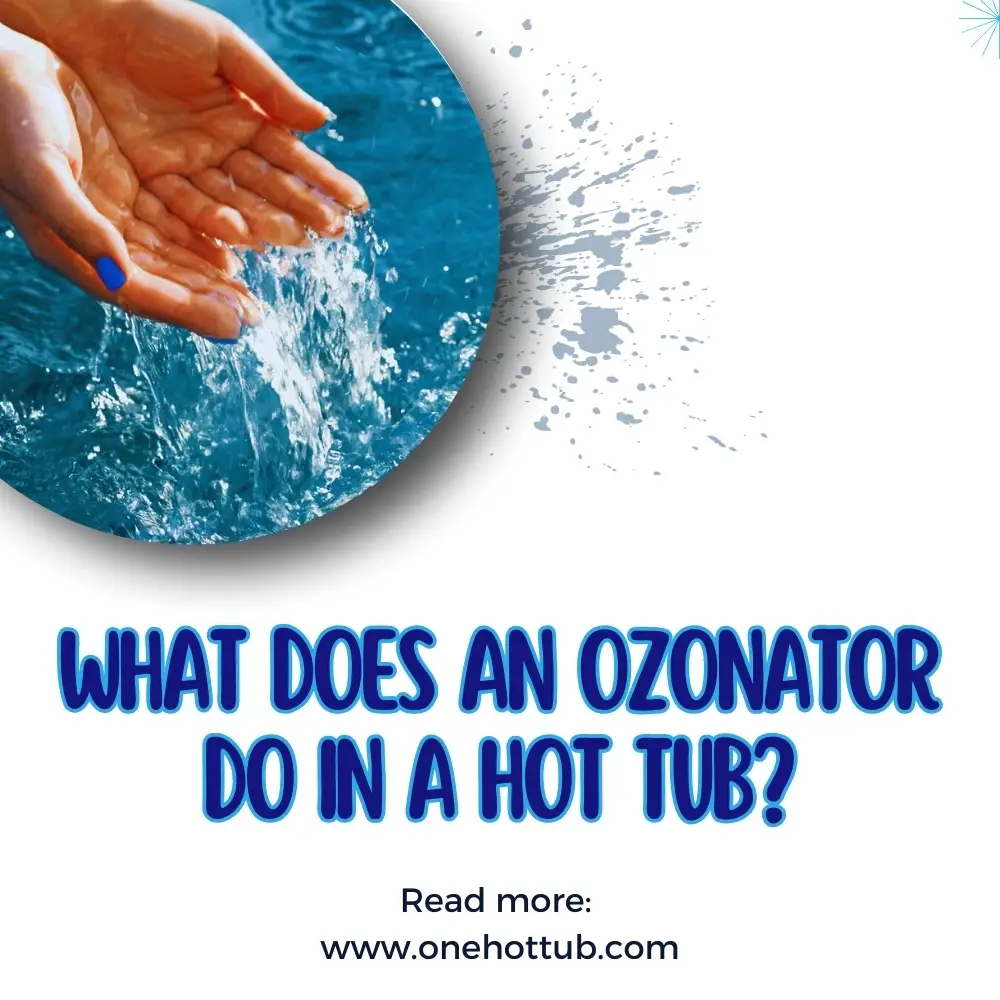Table of Contents - What Does An Ozonator Do In A Hot Tub?
This blog post may contain affiliate links. As an Amazon Associate I earn from qualifying purchases.
What Does An Ozonator Do In A Hot Tub?

What Is an Ozonator in a Hot Tub?
The Science Behind Ozone (O3)
How Ozone Purifies Water
- Bacterial Cell Destruction – Ozone punches holes in bacterial cell walls until they burst – game over for those germs!
- Contaminant Breakdown – It tackles all sorts of yucky stuff:
- Bacteria and viruses
- Body oils and lotions
- Makeup and perfumes
- Sweat and other organic gunk
- Rapid Action – Unlike other sanitizers that take their sweet time, ozone works in seconds, quickly zapping harmful pathogens.
Different Types of Hot Tub Ozonators
Corona Discharge (CD) Ozonators:Ultraviolet (UV) Ozonators:Comparison Table: CD vs. UV Ozonators
| Feature | Corona Discharge Ozonators | UV Ozonators |
|---|---|---|
| Ozone Output | Higher output | Lower output |
| Lifespan | Longer operational life | Requires more frequent lamp replacement |
| Initial Cost | Higher initial investment | More affordable |
| Energy Efficiency | Less energy-efficient | More energy-efficient |
| Ideal For | Larger hot tubs | Smaller residential spas |
How Does an Ozonator Work in a Hot Tub?
 Image Source: https://pexels.com/
Image Source: https://pexels.com/
Corona Discharge Technology Explained
UV Light Ozonator Systems
The Ozone Injection Process
Benefits of Using an Ozonator
Reduced Chemical Usage (Up to 90%)
Improved Water Clarity and Quality
- Body oils and leftover beauty products
- Organic gunk
- Dissolved solids that make water cloudy
Extended Hot Tub Component Lifespan
- Pumps and motors
- Heaters and heating elements
- Plumbing and jets
- Seals and gaskets
Health Benefits for Sensitive Skin
- Skin and eye irritation
- That overwhelming “pool smell”
- Dry, itchy skin after your soak
Pros and Cons of Hot Tub Ozonators
Pros
- Reduces chemical usage by up to 90%
- Creates clearer, cleaner water
- Extends equipment lifespan
- Reduces skin and eye irritation
- Provides more natural water treatment
Cons
- Requires initial investment
- Needs replacement every 3-5 years
- Cannot completely eliminate sanitizer need
- May require additional maintenance
- Ozone gas can be harmful if not properly contained
Installing and Maintaining Your Hot Tub Ozonator
 Image Source: https://pexels.com/hot tub ozonator
Image Source: https://pexels.com/hot tub ozonator
DIY Installation Steps
- Mount your ozonator as high as possible in the equipment bay, ideally on a wooden support to keep it safe from splash damage
- Find the ozone suction connection (usually a capped 1/4″ vinyl air tube hiding in your equipment area)
- Snip off that cap and connect your check valve (pay attention to the flow direction arrows!)
- Connect one end of the clear vinyl tubing to the check valve and the other end to your ozonator
- Hook up your ozonator to power (double-check that the voltage matches your specs)
Creating a Hartford Loop for Protection
- Loop your ozone tubing upward so it rises higher than your hot tub’s water line
- Secure this loop with zip ties or mounting brackets so it stays put
- Make sure the highest point of your loop stays above the water level
Check Valve Maintenance
- Test it periodically by blowing through it – air should flow one way only
- Give it a vinegar bath to dissolve any mineral buildup
- Replace it yearly, even if it seems to be working fine
When to Replace Your Ozonator
| Ozonator Type | Replacement Timeline |
|---|---|
| UV Ozonators | 2-3 years (bulbs last 8,000-10,000 hours) |
| CD Ozonators | 3-5 years (MCD-50 models) |
| Del CDS Spa Eclipse | 2-3 years |
- Replace that clear ozone tubing yearly as it turns yellow and brittle
- Check for any cracks in barbed connections
- Make sure the indicator light on your ozone generator still works
Top Recommended Hot Tub Ozonators
 Image Source: https://pexels.com/
Image Source: https://pexels.com/
Best Budget-Friendly Option
Clarathon HCD-55 Spa Ozonator Kit
- Works with any voltage (120V/240V) – no electrical worries!
- Smart auto-sensing power technology
- Comes with everything you need – 6′ of tubing, check valve, and hose clamps
- One-year factory warranty to keep you covered
Del Ozone Eclipse Ozonator
Premium Performance Picks
Bullfrog Spas EOS™ O3 Enhanced Ozone System
- Double the ozone output of standard systems
- Clever ozone destruction technology
- Third-party testing confirms it kills 99.9% of nasty microorganisms
- Delivers a more potent ozone charge to your spa water
UltraPure EUV3 Hot Tub OzonatorBalboa WaveZone UV/O3 Combo
Ozonator Accessories Worth Considering
Ozone Turbo MixerOzonator Venturi Injector KitCheck Valves
FAQs
How can I tell if my ozonator is working properly?
- Look for those pretty “champagne bubbles” streaming steadily in your hot tub
- Check for a glowing indicator light on the ozonator unit
- Take a quick sniff when lifting your spa cover – a brief ozone smell is a good sign
- For a more direct test, carefully remove the ozone hose from the check valve – you should be able to smell ozone
How long do hot tub ozonators typically last?
- UV ozonators need new bulbs every 2-3 years
- Corona Discharge (CD) models typically last 3-5 years for MCD-50 chips
- Got a Del CDS Spa Eclipse? Plan on 2-3 years of service
Do I still need chemicals with an ozonator?
- Just 0.5 PPM chlorine (instead of the usual 1-3 PPM)
- Only 1.0 PPM bromine (rather than the standard 3-5 PPM)
- You’ll still need to keep an eye on pH and alkalinity – some things never change!
How long should my ozonator run each day?
- At minimum: 4-6 hours daily keeps things decent
- For best results: Let it run 24/7 for maximum cleaning power
- Adjust based on how often you use your tub – more splashing means more cleaning needed
Is ozone safe for my hot tub and health?
- Completely safe once dissolved in your spa water
- Gentle on your hot tub parts – no corrosion worries
- Much kinder to your skin and eyes than chlorine ever was
- The tiny amounts used in hot tubs pose no health concerns
What common ozonator problems should I watch for?
- A faulty check valve letting water sneak back where it shouldn’t
- Clogged filters reducing water pressure (and ozone distribution)
- Power supply hiccups affecting ozone production
- Water quality going downhill despite adding chemicals
How do I know if my hot tub ozonator is working correctly?What’s the typical lifespan of a hot tub ozonator?Do I still need to use chemicals if I have an ozonator in my hot tub?How long should I run my hot tub ozonator each day?Is ozone safe for my hot tub equipment and health?



